Gross domestic product grew by 2.2 per cent in 2018
The volume of gross domestic product grew by 2.2 per cent last year. Calculated at current prices, gross domestic product was 4.1 per cent higher than in 2017.
In October to December, gross domestic product grew by 0.7 per cent from the previous quarter and by 2.2 per cent compared to the fourth quarter of 2017. According to preliminary data compiled by Eurostat, gross domestic product in the EU28 area grew by 0.2 per cent in the last quarter of 2018 compared with the previous quarter.
Figure 1. Volume change of GDP from the previous quarter, seasonally adjusted, per cent
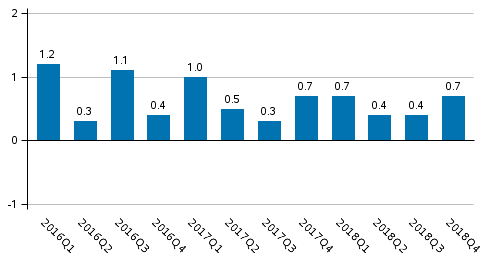
Finland’s national economy grew steadily throughout 2018, because GDP grew in every quarter by at least two per cent from twelve months back. However, the growth was not as strong as in 2016 and 2017, when the growth figures were close to three per cent.
In 2018, economic growth was divided evenly among manufacturing, construction and service industries. The volume of value added decreased only in the forest industry, where with the price rise, the current-priced value added nevertheless grew, and in financial and insurance activities, where inputs in structural changes in international groups, for example, increased costs of intermediate consumption, for which reason value added in these industries remained negative.
The employment situation was better in 2018 than the year before when examined in the light of both the employment rate and unemployment rate.
Output
In the fourth quarter, the combined volume of value added generated by industries grew by 0.5 per cent from the previous quarter. In the whole of 2018, value added was 2.0 per cent higher than in the year before.
The growth in value added was influenced by favourable development in manufacturing, construction and private services. Examined in current prices, especially building construction, trade and several manufacturing industries grew.
Figure 2. Changes in the volume of value added generated by industries in 2018 compared to one year ago, per cent
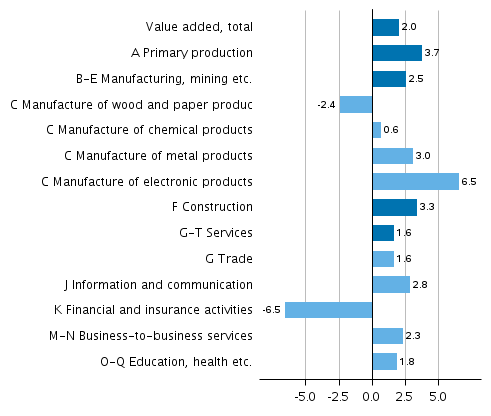
Figure 3. Changes in the volume of value added generated by industries in the fourth quarter of 2018 compared to one year ago, working-day adjusted, per cent
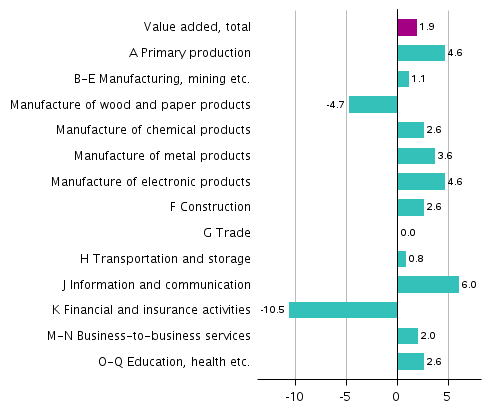
Figure 4. Changes in the volume of value added generated by industries in the fourth quarter of 2018 compared to the previous quarter, seasonally adjusted, per cent

The volume of value added in primary production, that is, agriculture, forestry and fishery, went up by five per cent in October to December from one year ago. Primary production grew by four per cent over the whole of 2018. Output in agriculture decreased by three per cent measured by volume but examined in current prices, grew by two per cent as a result of the rise in prices. The volume of output in the forest industry increased by six per cent. The price of wood also rose, as a result of which the forest industry grew by 11 per cent in current prices.
In the last quarter of the year, value added in manufacturing (industries B to E) went up by one per cent compared with the year before. The volume of output grew in most manufacturing industries in 2018: the metal industry grew by three per cent, the electrical and electronics industry by seven per cent and energy and water supply by four per cent. Examined in volume of output, the forest industry contracted by two per cent and the chemical industry grew by just one per cent, but both went up by six per cent in current prices. In total, the volume of manufacturing industries went up by 2.5 per cent last year.
The volume of value added in construction grew in October to December by three per cent from the year before, as in the whole of 2018. Building construction increased clearly, but growth in civil engineering was more subdued.
From October to December, the volume of value added in service industries increased by two per cent from the quarter of one year ago. Over the whole year 2018, service industries grew by 1.6 per cent. Private services grew by two per cent and general government services by half a per cent. Growth was most significant in the industries of trade, information and communication, business services and public administration and health care services.
Imports, exports, consumption and investments
In 2018, total demand in the national economy grew by 2.1 per cent from the previous year. In addition to growth in consumption, demand was boosted by increases in residential and other building construction investments, but due to growing imports, the effect of net exports clearly depressed demand. It was exceptional that inventories grew considerably in the third quarter of the year.
Figure 5. Changes in the volume of main supply and demand items in 2018 compared to one year ago, per cent
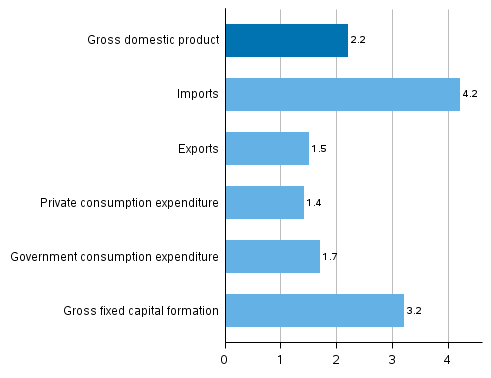
Figure 6. Changes in the volume of main supply and demand items in the fourth quarter of 2018 compared to one year ago, working-day adjusted, per cent
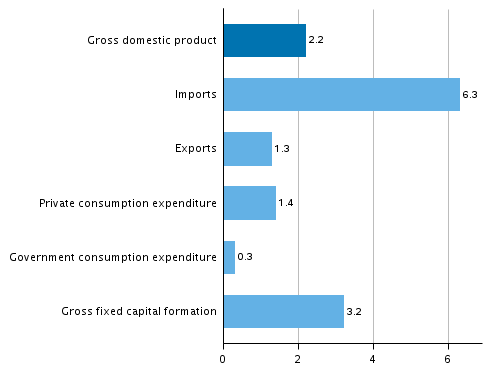
Figure 7. Changes in the volume of main supply and demand items in the fourth quarter of 2018 compared to one year ago, seasonally adjusted, per cent
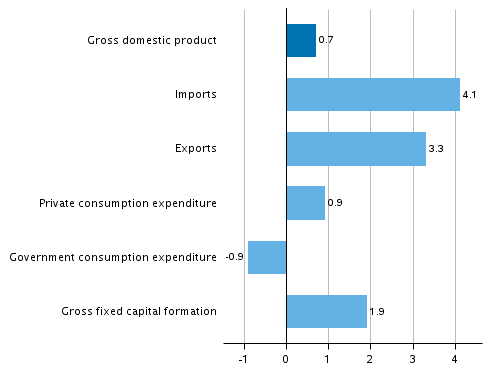
The volume of exports grew by one per cent and that of imports by six per cent in October to December year-on-year. In the whole year 2018, the volume of exports grew by 1.5 per cent: the volume of goods exports went up by one per cent and that of service exports by three per cent. The volume of imports went up by 4.2 per cent: the volume of goods imports grew by three per cent and that of service imports by as much as eight per cent. The prices of import goods and particularly of export goods rose clearly, and calculated in current prices, imports of goods grew by seven per cent and exports of goods by six per cent.
In the last quarter of 2018, the volume of private consumption increased by one per cent from the previous quarter and by one-and-a-half per cent from twelve months back. In the whole year, the volume of private consumption expenditure grew by 1.4 per cent. Consumption of durable consumer goods continued to grow as in previous years, although in the latter half of the year, consumption appears to have decreased at least compared to previous quarters.
The volume of government consumption expenditure decreased in October to December by one per cent from the previous quarter and remained more or less on level with the previous year. In the whole of 2018, the volume of government consumption expenditure went up by 1.7 per cent.
The volume of gross fixed capital formation, that is, investments grew in the last quarter of 2018 by two per cent from the previous quarter and by three per cent from one year ago. Over the whole year, investments increased by 3.2 per cent. The volume of building investments was four per cent, the volume of investments in machinery, equipment and transport equipment two per cent, and investments in research, development and software were two per cent higher than in 2017.
Employment, wages and salaries and national income
In October to December, the number of employed persons was 0.8 per cent higher than in the previous quarter. The number of hours worked in the national economy increased by 0.6 per cent from the previous quarter.
In 2018, the number of employed persons grew by 2.7 per cent and the number of hours worked by 2.6 per cent from the year before. According to Statistics Finland's Labour Force Survey, the unemployment rate was 6.0 per cent in October to December and 7.4 per cent in the whole year, having been 7.6 per cent in October to December 2017 and 8.6 per cent in the whole year 2017.
Labour productivity, or the volume of gross value added per hour worked, decreased by 0.6 per cent last year.
The nominal wages and salaries bill of the national economy grew by 4.7 per cent. Social contributions paid by employers grew by 0.4 per cent from last year.
The operating surplus (net), which in business bookkeeping corresponds roughly with operating profit, grew by 5.8 per cent from 2017. Gross national income was 3.6 per cent higher in nominal terms than in the previous year.
The available data
The preliminary data are based on the source information on economic development available on 25 February 2019. The annual level data for 1990 to 2017 correspond with the National Accounts data released on 31 January 2019, except for those on the rest of the world sector (imports, exports, primary income from/to the rest of the world), which may have become revised.
The preliminary data for 2018 that contain more detailed data on general government and other sector accounts will be released on 15 March 2019. The data of this release will be revised at that time. The revised data will also be updated in the database tables of the Quarterly National Accounts but no actual release of the Quarterly National Accounts will be compiled.
National Accounts for 2018 with more detailed data contents will be released on 20 June 2019.
Data concerning the first quarter of 2019 will be released on 29 May 2019, when the data for previous quarters will also be revised. A flash estimate on GDP development for January to March will be released in connection with the Trend Indicator of Output on 15 May 2019.
Due to the benchmarking and seasonal adjustment methods, quarterly data in the entire time series may become slightly revised in connection with each release. However, the largest revisions take place during the two to three years following the release on a quarter, because final annual accounts data are published at a lag of around two years from the end of the statistical reference year. Seasonally adjusted and trend time series always become revised against new observations irrespective of whether the original time series becomes revised or not.
The quality description can be accessed at (in Finnish): http://www.tilastokeskus.fi/til/ntp/laa.html .
Methodological description of Quarterly National Accounts.Source: National Accounts 2018, 4:th quarter. Statistics Finland
Inquiries: Samu Hakala 029 551 3756, Antti Kosunen 029 551 3613, kansantalous.suhdanteet@stat.fi
Director in charge: Ville Vertanen
Updated 28.2.2019
Official Statistics of Finland (OSF):
Quarterly national accounts [e-publication].
ISSN=1797-9765. 4th quarter 2018,
Gross domestic product grew by 2.2 per cent in 2018
. Helsinki: Statistics Finland [referred: 10.12.2025].
Access method: http://stat.fi/til/ntp/2018/04/ntp_2018_04_2019-02-28_kat_001_en.html

